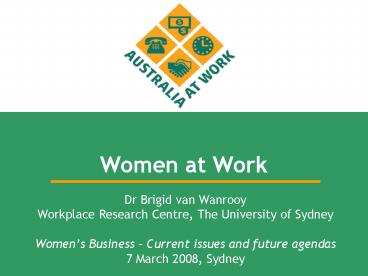Women at Work PowerPoint PPT Presentation
1 / 19
Title: Women at Work
1
Women at Work
- Dr Brigid van Wanrooy
- Workplace Research Centre, The University of
Sydney - Womens Business Current issues and future
agendas - 7 March 2008, Sydney
2
Research Objective
- To inform debate and policy development on
Australian working life
provide an overview of womens current labour
market experiences
3
A Research Imperative
- Policy environment in a state of flux
- Potential labour shortages
- aging population
- declining/stabilising fertility
- What are the consequences for women?
- Is progress being made?
4
Methodology
- Telephone survey Australia-wide
- In the labour force in March 2006, aged 16-58
- Data collected once a year 2007-2011
- n8,341 Women n3,905
- Workers perceptions of working life
5
A study of working life
6
How are women faring?
- Women compared to men in part-time and full-time
jobs - Part-time jobs are not the same for men and women
- Women compared to men in high and low skilled jobs
7
Female and Male workforces
Men
Women
8
Permanency in the workforce
- Women hold 74 per cent of part-time jobs
- Only 42 per cent of part-time jobs are permanent
- 77 per cent of men are in permanent jobs
- 66 per cent of women are in permanent jobs
9
Employment and the life course
10
Part-time employment
- Women
- Prime aged
- With children
- Higher skilled
- Permanent
- Longer tenure
- Regular hours
- Men
- Young
- Studying
- Lower skilled
- Casual
- Short tenure
- Unsociable hours
11
Full-time employment
- Women
- Professionals
- Standard hours
- Unpaid hours
- Men
- Managerial
- Unsociable hours
- Longer hours
12
Women in industrial relations
- Public sector union membership higher for women
among part-time employees. - Female union membership in the private sector is
lower (11 compared to 16 men). - High degree of satisfied non-members in private
sector part-time employment (69 women compared
to 59 men). - Despite this, women rely on collective
arrangements (female v male) - Award plays a role (70 v 60)
- Award reliance (46 v 35)
- Collective pay setting (67 v 56)
13
Women in negotiation skill level
- Reliance on collective arrangements leads women
being less likely to say that they can negotiate
pay directly with their employer (43 v 54 men)
14
Negotiation in collective and individual
workplaces
15
Womens attitudes toward work
- Part-time employees are more likely to say they
have control over their work hours. - Compared to men
- Women feel less secure in the labour market.
- Women are more likely to trust managers.
- Women in full-time jobs and high-skilled jobs are
more likely to feel overloaded.
16
Two labour markets
- Different experiences for employees
- Low pay low skill compared to high pay high
skill
High Nurses, Accountants, Teachers 44 are women
Low Cleaners, Call centre workers, Sales
assistants, Child carers 53 are women
17
Women High pay and high skill
- More professional, less managerial
- Overloaded
- Unpaid hours
- Casual (14 compared to 7 men)
- Have a degree (55 compared to 44 men)
- Award plays a role (54 compared to 44 men)
18
Women low pay and low skill
- In smaller workplaces
- 42 per cent are in workplaces less than 20
- Caring and white collar occupations
- Community personal service workers (24)
- Clerical administrative workers (36)
- Casual (43 compared to 36 men)
19
Women in the workforce A research imperative
- Australia at Work enables us to map the broad
terrain of womens working lives - Australian IR policy is enduring constant change
- Requires research and evidence, to identify
- social and economic impacts
- unintended consequences
- areas for policy refinement

